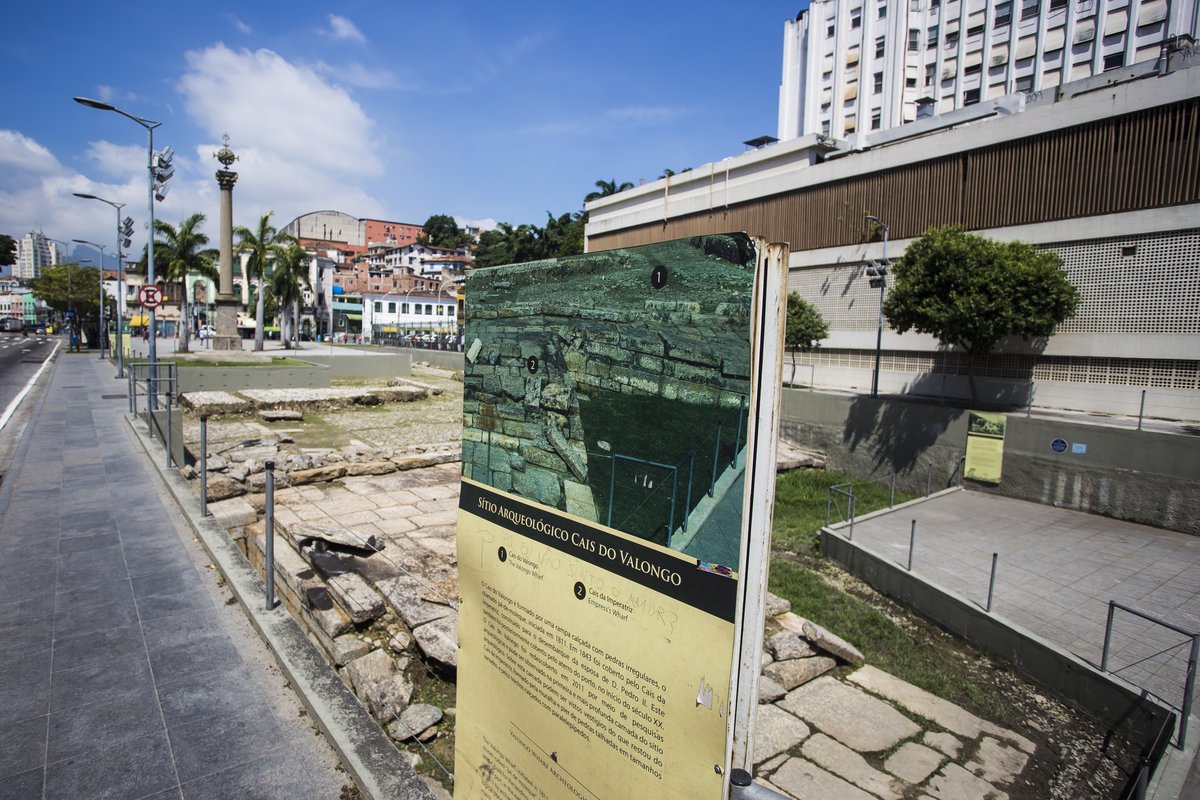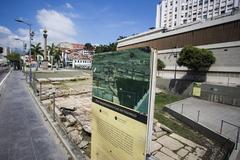
Comprehensive Guide to Visiting Cais do Valongo, Rio de Janeiro, Brazil
Publication Date: 19/07/2024
Introduction to Cais do Valongo
Cais do Valongo, situated in Rio de Janeiro, Brazil, is a site steeped in historical, cultural, and archaeological significance. Constructed in 1811, it served as the primary docking point for enslaved Africans arriving in Brazil, a country that stood as the largest importer of enslaved Africans in the Americas during the transatlantic slave trade. The dock, built to replace the old Cais da Imperatriz, witnessed the arrival of an estimated 500,000 enslaved Africans between 1811 and 1831, marking it as the largest slave market in the Americas (UNESCO) (Museu de Arte do Rio). Its rediscovery in 2011, during urban revitalization projects, unearthed a wealth of artifacts, including shackles, pottery, and personal items, providing invaluable insights into the lives of those who passed through the dock. This led to its designation as a UNESCO World Heritage Site in 2017, underscoring its global importance as a testament to the resilience and suffering of enslaved Africans and the enduring legacy of slavery in Brazil. Today, Cais do Valongo is not only a historical site but also a poignant symbol of the African diaspora’s impact on Brazilian culture, reflected in music, dance, religion, and cuisine.
Table of Contents
History of Cais do Valongo
Origins and Construction
Cais do Valongo, located in Rio de Janeiro, Brazil, is a site of profound historical significance. Constructed in 1811, it served as the primary port for the arrival of enslaved Africans in Brazil. The dock was built to replace the old Cais da Imperatriz, which had become inadequate due to the increasing volume of the transatlantic slave trade. The construction of Cais do Valongo was a direct response to the burgeoning demand for enslaved labor in Brazil, particularly in the coffee and sugar plantations.
The Transatlantic Slave Trade
Between 1811 and 1831, Cais do Valongo was the entry point for an estimated 500,000 enslaved Africans. This period marked the height of the transatlantic slave trade, with Brazil being the largest importer of enslaved Africans in the Americas. The conditions at the dock were harrowing; newly arrived Africans were subjected to inhumane treatment, including immediate quarantine and inspection. Many were sold directly at the dock or transported to nearby markets.
Abolition and Transformation
The transatlantic slave trade was officially abolished in Brazil in 1831, but illegal trading continued for several decades. By the mid-19th century, the significance of Cais do Valongo began to wane. In 1843, the dock was transformed into Cais da Imperatriz in honor of the arrival of Princess Teresa Cristina of Bourbon-Two Sicilies, who was to marry Emperor Dom Pedro II. This transformation involved covering the original dock with a new layer of stone, effectively burying its dark history.
Rediscovery and Archaeological Significance
Cais do Valongo remained hidden until its rediscovery during urban revitalization projects in 2011. Archaeological excavations unearthed a wealth of artifacts, including shackles, pottery, and personal items belonging to the enslaved Africans. These findings provided invaluable insights into the lives of those who passed through the dock. The rediscovery of Cais do Valongo was a pivotal moment in acknowledging Brazil’s role in the transatlantic slave trade and the enduring legacy of slavery in the country.
UNESCO World Heritage Site
In 2017, Cais do Valongo was designated a UNESCO World Heritage Site. This recognition underscored the global significance of the site as a testament to the resilience and suffering of enslaved Africans. The designation also highlighted the importance of preserving and commemorating sites associated with the transatlantic slave trade. UNESCO’s recognition has spurred efforts to develop the site as a place of memory and education, ensuring that the history of Cais do Valongo is not forgotten.
Cultural and Historical Impact
Cais do Valongo is not just a historical site; it is a symbol of the African diaspora’s enduring impact on Brazilian culture. The dock’s history is intertwined with the development of Afro-Brazilian cultural expressions, including music, dance, religion, and cuisine. The site serves as a poignant reminder of the contributions and struggles of Afro-Brazilians throughout history.
Visitor Information
Visiting Hours and Tickets
Cais do Valongo is open to the public daily from 9:00 AM to 5:00 PM. Admission is free, but guided tours are available for a fee. Tickets for guided tours can be purchased on-site or online through the official website.
Travel Tips
The best time to visit Cais do Valongo is during the cooler months from May to September. The site is easily accessible by public transportation, with several bus lines and the metro stopping nearby. Visitors should wear comfortable walking shoes and bring water, as the tour involves a fair amount of walking.
Nearby Attractions
Cais do Valongo is situated in the historical district of Rio de Janeiro, close to other notable sites such as the Museum of Tomorrow, the Rio Art Museum, and the Pedra do Sal, a historic site known for its samba culture. Visitors can easily spend a day exploring these attractions and immersing themselves in the rich history and culture of the area.
Accessibility
Efforts have been made to ensure that Cais do Valongo is accessible to all visitors. The site features ramps and pathways suitable for wheelchairs, and guided tours are available in multiple languages, including English, Portuguese, and Spanish.
FAQ
What are the visiting hours for Cais do Valongo?
Cais do Valongo is open daily from 9:00 AM to 5:00 PM.
How much are tickets to Cais do Valongo?
Admission to Cais do Valongo is free. Guided tours are available for a fee, with tickets purchasable on-site or online.
What other attractions are near Cais do Valongo?
Nearby attractions include the Museum of Tomorrow, the Rio Art Museum, and the historic Pedra do Sal.
Conclusion
Cais do Valongo stands as a site of immense historical and cultural importance, serving as a stark reminder of the atrocities of the transatlantic slave trade and the resilience of the African diaspora. Its rediscovery and subsequent designation as a UNESCO World Heritage Site have ensured that this history is preserved and remembered, fostering a space for education and reflection. Visitors to Cais do Valongo can engage deeply with its rich history, explore nearby attractions, and gain a profound understanding of the site’s significance. The ongoing efforts to preserve this site and the cultural expressions it represents highlight the importance of acknowledging and honoring the contributions and struggles of Afro-Brazilians throughout history. For more detailed information, you can visit the UNESCO World Heritage Site page on Cais do Valongo. Stay up to date with the latest news and events by downloading our mobile app, Audiala, and following us on social media.
Sources and References
- UNESCO. (2017). Cais do Valongo. https://whc.unesco.org/en/list/1548/
- Museu de Arte do Rio. (n.d.). http://www.museudeartedorio.org.br/




















































